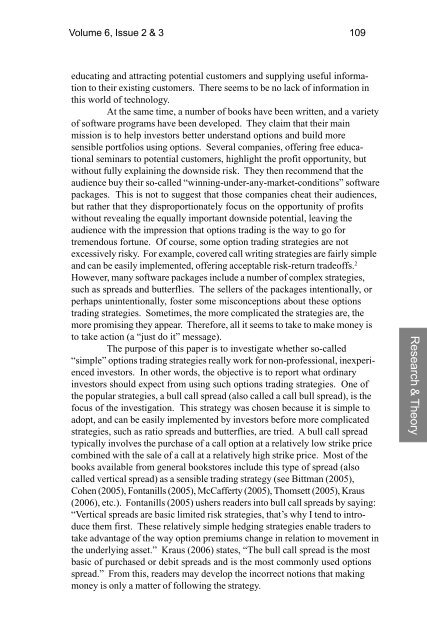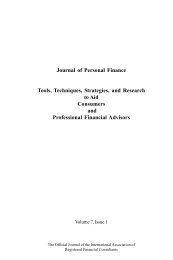3433-vol. 6 issue 2-3.pmd - iarfc
3433-vol. 6 issue 2-3.pmd - iarfc
3433-vol. 6 issue 2-3.pmd - iarfc
You also want an ePaper? Increase the reach of your titles
YUMPU automatically turns print PDFs into web optimized ePapers that Google loves.
Volume 6, Issue 2 & 3 109<br />
educating and attracting potential customers and supplying useful information<br />
to their existing customers. There seems to be no lack of information in<br />
this world of technology.<br />
At the same time, a number of books have been written, and a variety<br />
of software programs have been developed. They claim that their main<br />
mission is to help investors better understand options and build more<br />
sensible portfolios using options. Several companies, offering free educational<br />
seminars to potential customers, highlight the profit opportunity, but<br />
without fully explaining the downside risk. They then recommend that the<br />
audience buy their so-called “winning-under-any-market-conditions” software<br />
packages. This is not to suggest that those companies cheat their audiences,<br />
but rather that they disproportionately focus on the opportunity of profits<br />
without revealing the equally important downside potential, leaving the<br />
audience with the impression that options trading is the way to go for<br />
tremendous fortune. Of course, some option trading strategies are not<br />
excessively risky. For example, covered call writing strategies are fairly simple<br />
and can be easily implemented, offering acceptable risk-return tradeoffs. 2<br />
However, many software packages include a number of complex strategies,<br />
such as spreads and butterflies. The sellers of the packages intentionally, or<br />
perhaps unintentionally, foster some misconceptions about these options<br />
trading strategies. Sometimes, the more complicated the strategies are, the<br />
more promising they appear. Therefore, all it seems to take to make money is<br />
to take action (a “just do it” message).<br />
The purpose of this paper is to investigate whether so-called<br />
“simple” options trading strategies really work for non-professional, inexperienced<br />
investors. In other words, the objective is to report what ordinary<br />
investors should expect from using such options trading strategies. One of<br />
the popular strategies, a bull call spread (also called a call bull spread), is the<br />
focus of the investigation. This strategy was chosen because it is simple to<br />
adopt, and can be easily implemented by investors before more complicated<br />
strategies, such as ratio spreads and butterflies, are tried. A bull call spread<br />
typically in<strong>vol</strong>ves the purchase of a call option at a relatively low strike price<br />
combined with the sale of a call at a relatively high strike price. Most of the<br />
books available from general bookstores include this type of spread (also<br />
called vertical spread) as a sensible trading strategy (see Bittman (2005),<br />
Cohen (2005), Fontanills (2005), McCafferty (2005), Thomsett (2005), Kraus<br />
(2006), etc.). Fontanills (2005) ushers readers into bull call spreads by saying:<br />
“Vertical spreads are basic limited risk strategies, that’s why I tend to introduce<br />
them first. These relatively simple hedging strategies enable traders to<br />
take advantage of the way option premiums change in relation to movement in<br />
the underlying asset.” Kraus (2006) states, “The bull call spread is the most<br />
basic of purchased or debit spreads and is the most commonly used options<br />
spread.” From this, readers may develop the incorrect notions that making<br />
money is only a matter of following the strategy.<br />
Research & Theory
















